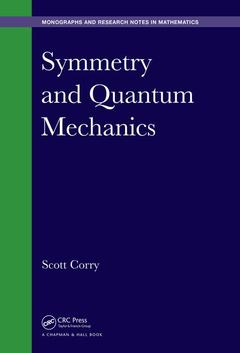Description
Symmetry and Quantum Mechanics
Chapman & Hall/CRC Monographs and Research Notes in Mathematics Series
Author: Corry Scott
Language: English
Subjects for Symmetry and Quantum Mechanics:
Keywords
Lie Algebra; lie; Irreducible Representation; algebra; Vector Space; orthonormal; Lie Group; basis; Spin Observable; vector; Spinor Space; space; Lie Algebra Su; angular; Tangent Space; momentum; Stern Gerlach Devices; double; Spin; cover; Spin Angular Momentum; Skew Hermitian Matrices; Orthonormal Basis; Angular Momentum; Lie Bracket; Quantum Observable; Hermitian Operator; Real Lie Algebra; Self-adjoint Operator; Group SU; Orbital Angular Momentum; Tensor Product; Complex Irreducible Representations; Dirac Equation; Invariant Subspace
· 15.6x23.4 cm · Hardback
Description
/li>Contents
/li>Biography
/li>
Structured as a dialogue between a mathematician and a physicist, Symmetry and Quantum Mechanics unites the mathematical topics of this field into a compelling and physically-motivated narrative that focuses on the central role of symmetry.
Aimed at advanced undergraduate and beginning graduate students in mathematics with only a minimal background in physics, this title is also useful to physicists seeking a mathematical introduction to the subject. Part I focuses on spin, and covers such topics as Lie groups and algebras, while part II offers an account of position and momentum in the context of the representation theory of the Heisenberg group, along the way providing an informal discussion of fundamental concepts from analysis such as self-adjoint operators on Hilbert space and the Stone-von Neumann Theorem. Mathematical theory is applied to physical examples such as spin-precession in a magnetic field, the harmonic oscillator, the infinite spherical well, and the hydrogen atom.
Physical Space.
Modeling space
Real linear operators and matrix groups
SO(3) is the group of rotations
Spinor SpaceAngular momentum in classical mechanics
Modeling spin
Complex linear operators and matrix groups
The geometry of SU(2). The tangent space to the circle U(1) = S1
The tangent space to the sphere SU(2) = S3
The exponential of a matrix. SU(2) is the universal cover of SO(3)
Back to spinor space
Observables and Uncertainty
Spin observables
The Lie algebra su(2)
Commutation relations and uncertainty
Some related Lie algebras
Warm-up: the Lie algebra u(1)
The Lie algebra sl2(C)
The Lie algebra u(2)
The Lie algebra gl2(C)
DynamicsTime-independent external fields
Time-dependent external fields
The energy-time uncertainty principle
Conserved quantities.
Higher Spin.Group representations.
Representations of SU(2).
Lie algebra representations.
Representations of su(2)C = sl2(C).
Spin-s particles.
Representations of SO(3).
The so(3)-action
Comments about analysis.
Multiple Particles.
Tensor products of representations.
The Clebsch-Gordan problem.
Identical particles—spin only.
A One-dimensional World.
Position.
Momentum
The Heisenberg Lie algebra and Lie group
The meaning of the Heisenberg group action
Time-evolution
The free particle
The infinite square well
The simple harmonic oscillator
A Three-dimensional World
Position
Linear momentum
The Heisenberg group H3 and its algebra h3
Angular momentum
The Lie group G = H3 o SO(3) and its Lie algebra g
Time-evolution
The free particle
The three-dimensional harmonic oscillator
Central potentials
The infinite spherical well
Two-particle systems
The Coulomb potential
Particles with spin
The hydrogen atom
Identical particles
Towards a Relativistic TheoryGalilean relativity
Special relativity
SL2(C) is the universal cover of SO+(1, 3)
The Dirac equation
Appendices
Linear algebra
Vector spaces and linear transformations
Inner product spaces and adjoints
Multivariable calculus
Analysis
Hilbert spaces and adjoints
Some big theorems
Solutions to selected exercises




